-
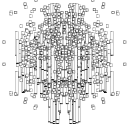 solipp
posted in technical issues • read more
solipp
posted in technical issues • read more@Moothart i never used [abl-link~], so i don't know how it behaves exactly. You can try something like this maybe

or use the set method for change (check the helpfile) -
-
 solipp
posted in technical issues • read more
solipp
posted in technical issues • read moreyou can also [del 0] or just [del] like this:
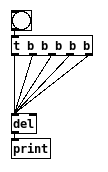
however, this will force any bang to come last in the trigger order. If you rely on trigger in this part in your patch you'd need another [del] to correct it:
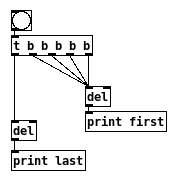
-
 solipp
posted in news • read more
solipp
posted in news • read moreVersion 0.70 is now available on deken.
I added some simple but convenient objects:
pp.amp~ a simple signal multiplier
pp.adsr~ adsr/adr envelope generator
pp.xfade~ signal crossfader
pp.shiftlfo~ a LFO that can generate irregular rhythmic patternspp.dynamics~ now has an option to enable feedback compression
Some parameter sliders are now colored light orange in the GUI. This indicates that the slider does not cover the full range of the parameter and is intended to encourage experimenting with values that are above or below the range of the slider.
fixed some minor bugs.
Happy patching!
-
 solipp
posted in news • read more
solipp
posted in news • read more@qhr33k Thanks!
about this sidechain thing; yes you would need to feed the compressor an audio signal and use the sidechain output to let's say duck the tail of a reverb (that's just an example, you can do whatever you want with this). In this case you would multiply the 100% wet reverb with the signal from the sidechain outlet of the compressor like this:
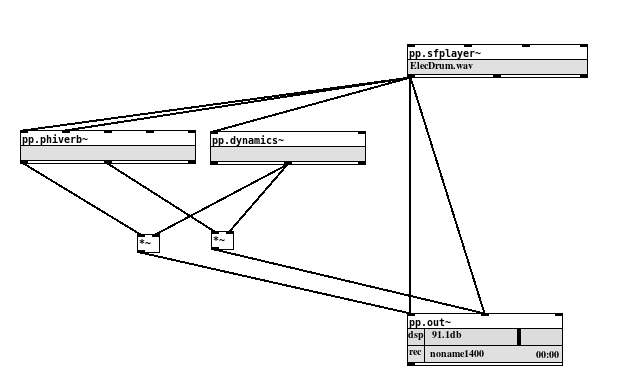
sidechain_compression.pdThe presets are more or less didactic, you can use them as a starting point and then change the parameters until they fit your needs. In the case above you'd use the "compress" preset. I think what confuses you is the preset "Env.follow(sidechain)". This one is an envelope follower, the comment (sidechain) hints that the envelope is the signal from the sidechain outlet. Hope that makes sense?
-
 solipp
posted in technical issues • read more
solipp
posted in technical issues • read moreI feel a bit like the "spray everywhere" solution would require more object copy/paste -- mine just has "; next symbol instr1" where the other needs a [t], a [s], a [r], and an [f].
well, you can wrap it into a subpatch and copy/paste that : )
Essentially both methods are not complicated, they just have to be implemented in a low level language as @oid pointed out. -
 solipp
posted in technical issues • read more
solipp
posted in technical issues • read morereading this thread, what i understand so far is this is about calling some function, store its output and retrieve it at a given point... Something like this in pd?
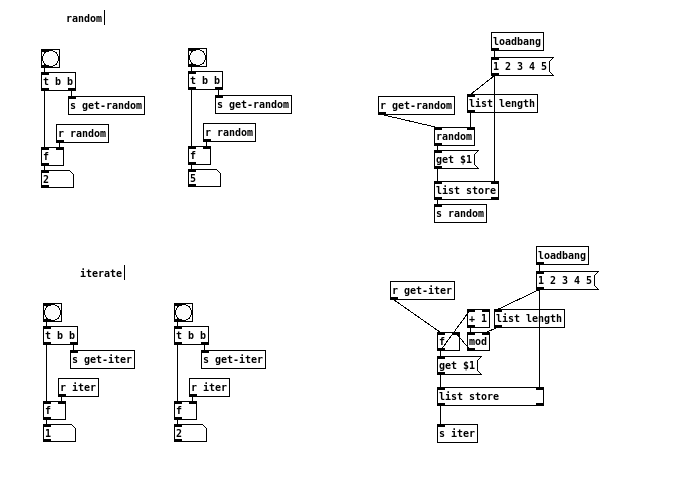 do i miss something?
do i miss something?
` -
 solipp
posted in technical issues • read more
solipp
posted in technical issues • read morei made this abstraction a while ago bezier.zip. There is also an abstraction "pp.xycurve" to draw and read from 2d bezier curves in the audiolab library: https://forum.puredata.info/topic/12334/audiolab-is-now-available-on-deken
-
 solipp
posted in technical issues • read more
solipp
posted in technical issues • read more@morast did you try the pp.spat8~ mentioned above? It's an vanilla abstraction and should run in an up to date pd version on a raspberry without issues.
You can find it in the deken repos (help -> find externals -> search for audiolab)Check it's helpfile, there is a signal controlled spread parameter. Not sure if that is what you mean by widening function.
-
 solipp
posted in news • read more
solipp
posted in news • read moreA new version is now available on deken, v0.63.
added 2 new objects:
pp.pantd~ stereo panner with time delay
pp.grainer-mc~ a granular sampler with multi-channel signal outletA new example 15-train_of_sounds.pd showcases the use of some audiolab abstractions with pd's multi-channel signal connections.
Example 14-glitchfest.pd is also new and just a lot of fun to play around with.fixed some bugs as well.
Happy patching!

